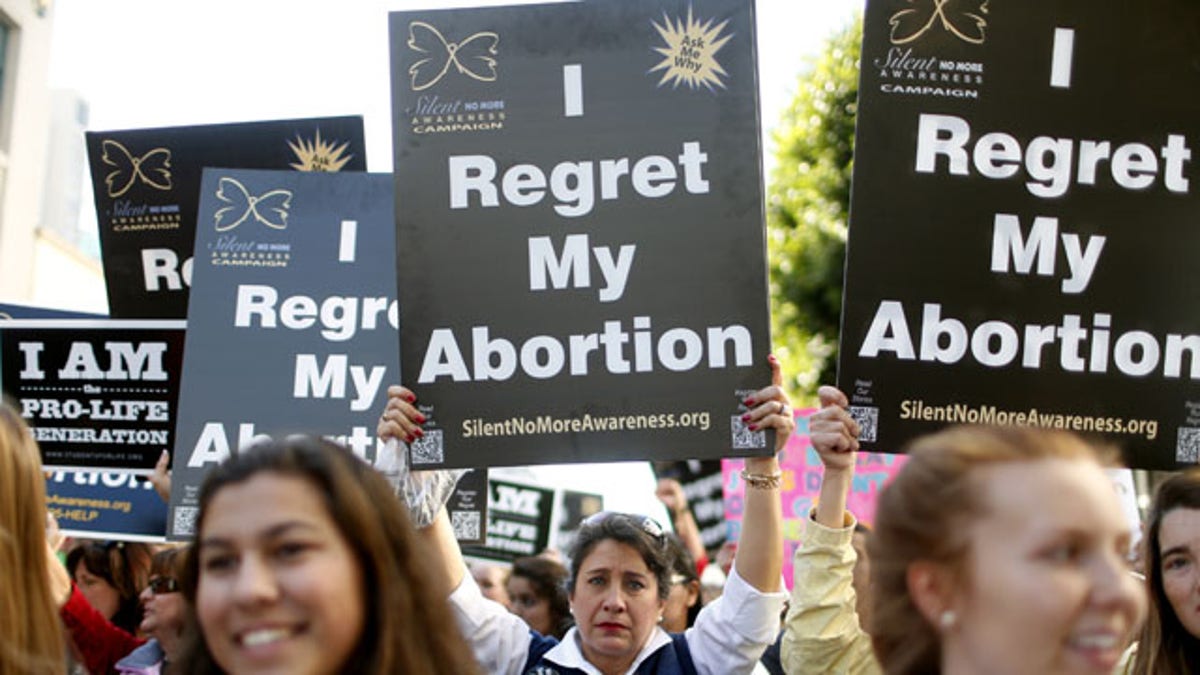
January 25, 2014: Abortion opponent Georgette Forney holds a sign stating "I regret my abortion" during the "Walk for Life" rally and march in San Francisco. (AP)
NEW YORK – The U.S. abortion rate declined to its lowest level since 1973, and the number of abortions fell by 13 percent between 2008 and 2011, according the latest national survey of abortion providers conducted by a prominent research institute.
The Guttmacher Institute, which supports legal access to abortion, said in a report being issued Monday that there were about 1.06 million abortions in 2011 — down from about 1.2 million in 2008. Guttmacher's figures are of interest on both sides of the abortion debate because they are more up-to-date and in some ways more comprehensive than abortion statistics compiled by the federal Centers for Disease Control and Prevention.
According to the report, the abortion rate dropped to 16.9 abortions per 1,000 women ages 15-44 in 2011, well below the peak of 29.3 in 1981 and the lowest since a rate of 16.3 in 1973.
Guttmacher and other groups supporting abortion rights have been apprehensive about the recent wave of laws restricting abortion access that have been passed in Republican-controlled legislatures. However, the report's authors said the period that they studied — 2008 to 2011 — predates the major surge of such laws starting with the 2011 legislative session.
The lead author, Rachel Jones, also said there appeared to be no link to a decline in the number of abortion providers. According to the report, the total number of providers dropped by 4 percent, to 1,720, between 2008 and 2011, and the number of abortion clinics declined by just 1 percent to 839.
According to Jones, the drop in abortions was likely linked to a steep national decline in overall pregnancy and birth rates.
"Contraceptive use improved during this period, as more women and couples were using highly effective long-acting reversible contraceptive methods," she said. "Moreover, the recent recession led many women and couples to want to avoid or delay pregnancy and childbearing."
While the overall abortion rate declined, the proportion of abortions entailing early medication procedures continued to increase. According to Guttmacher, about 239,400 abortions of this type were performed in 2011, representing 23 percent of all non-hospital abortions, an increase from 17 percent in 2008.
Carol Tobias, president of the National Right to Life Committee, described the overall drop in abortion numbers as evidence that the anti-abortion movement's lobbying and legislative efforts were having an impact.
"It shows that women are rejecting the idea of abortion as the answer to an unexpected pregnancy," she said.
Americans United for Life, another anti-abortion group engaged in the efforts to pass restrictive state laws, said Guttmacher's numbers should be viewed skeptically because they are based on voluntary self-reporting by abortion providers.
"It is impossible really to know the true abortion rate," said the group's president, Charmaine Yoest.
The report marked the 16th time since 1973, when abortion was legalized nationwide, that Guttmacher has attempted to survey all known abortion providers in the U.S. However, a section of the new report acknowledges that some abortions might not be tallied.
The highest abortion rates were in New York, Maryland, the District of Columbia, Delaware and New Jersey; the lowest were in Wyoming, Mississippi, South Dakota, Kentucky and Missouri. However, Guttmacher said many women in Wyoming and Mississippi, where providers are scarce, go out of state to get abortions.
